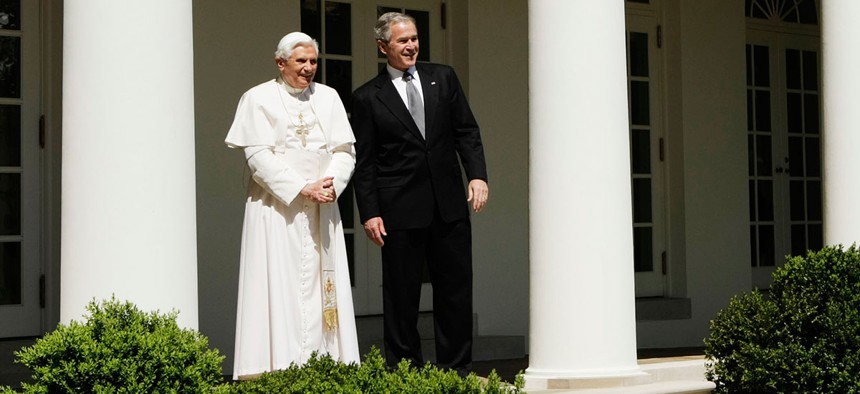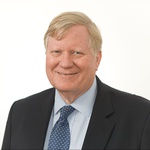
George W. Bush and Pope Benedict XVI stand outside the Oval Office in 2008. Pablo Martinez Monsivais/AP file photo
Papal White House Visits Are Special, But They Sometimes Get Awkward
Meetings between popes and presidents have ranged from memorable to prickly.
Pope Francis’s arrival at the White House on Wednesday will be marked with all the pomp normally accorded a head of state, not unlike the ceremonies that welcomed so many previous world leaders over the years. But as aides to President Obama and several earlier presidents have learned, there is nothing routine when a president of the United States sits down with the leader of the world’s one billion Catholics.
For White House staffers, that is both good and bad. It’s good in that many staffers remember papal meetings as one of the highlights of their tenure. But it’s bad because no one really knows in advance what a pope is going to say behind closed doors. Most summits are tightly scripted. That doesn’t happen in a papal-presidential meeting, leading to awkward moments in some of the past sessions between 12 presidents and six pontiffs. Behind closed doors and away from the cameras, the talks have at times gone from blessings and generalities to strong disagreements and specifics.
Still, participants keep coming back to the uniqueness of these summits between the world’s top temporal and top religious leaders. “It was one of the most memorable things personally that I worked on,” recalled Anita McBride, who played the lead role for the George W. Bush administration in planning Pope Benedict XVI’s visit to the White House in 2008. “During my time in three different administrations, this totally rose to the top,” she told National Journal. “It is just on such a very different level from everything else.”
McBride is Catholic. But non-Catholic staffers give similar reports. Ari Fleischer, Bush’s first press secretary, was present for two meetings with Pope John Paul II. He laughingly acknowledged he had not given much thought to popes when he was a boy growing up Jewish in New York. “But this is special stuff—even if you’re not Catholic,” he said. “There is an other-worldliness to it. Unlike a summit meeting or other routine visit, even with the most important head of state, the papacy is unique. The trappings of office are different from anywhere else.”
Because John Paul was ailing and nearing death, his last meeting with Bush was “mostly ceremonial,” recalled Fleischer, with the president doing most of the talking. “But it had such an important air and feel to it. … Just to meet him was special. Popes have an air and a grace about them that sets them apart and makes them special even for those who aren’t Catholic.”
Fleischer still treasures a coin given him by the pope, just as McBride retains a rosary given her by Benedict. She recalled that Bush arranged for the pope to meet with the Catholics on his senior staff as well as some Bush family members who are Catholic.
That meeting made an impact on her. But even more, she said, she remembers how non-Catholics were affected. “There was not one person who was not moved by meeting the Holy Father. It doesn’t matter what faith you are, there is something extraordinarily moving and special about someone who is leading so many people. It is just on such a different level from other world leaders.”
There have, though, been some tensions in the past summits. President Woodrow Wilson, intending to keep the pope out of the postwar peace talks in Paris, initially refused to visit Benedict XV. He relented only when Joseph Tumulty, a Catholic and Wilson’s closest aide, insisted. The meeting, on January 9, 1919, did not go well.
According to a report in the National Catholic Review, Wilson was very much a “prickly Presbyterian” in the meeting, balking when the pope offered a traditional papal blessing. Wilson demanded an explanation. When the pope said the blessing was for everyone, Catholic and non-Catholic, the president turned to his staff and asked, “Are there any Catholics here?” The Catholics knelt and Wilson bowed his head for the blessing. He then rejected Benedict’s 10-point peace plan and refused to intervene to give control of Vatican City to the church instead of the anti-clerical Italian government.
More recent meetings have gone better but still have had moments of friction or embarrassment. John F. Kennedy, the first Catholic president, was watched carefully to see if he would kiss Paul VI’s ring. He didn’t, instead shaking his hand. Jimmy Carter had what was officially billed as a productive and friendly meeting with John Paul II in 1979. Twenty-five years later—just months after the pope’s death—a fuller picture emerged when Carter wrote Our Endangered Values. In the book, he described the pope as a “fundamentalist” and gave more details of their meeting, the first-ever visit by a pope to the White House.
Carter wrote that the pope “seemed to welcome a free exchange of views.” So he “disagreed with him on his perpetuation of the subservience of women and their exclusion from the priesthood.” This, wrote Carter, was “harmonious.” But, he added, “there was more harshness when we turned to the subject of liberation theology” in Latin America. The pope had cracked down on the priests espousing that. But Carter called them “heroes.”
The next president to meet with John Paul was Ronald Reagan, who was a favorite of the Vatican after he opened diplomatic relations with the Holy See in 1984. This act carried Reagan past the embarrassment of him noticeably dozing off during a meeting with John Paul II in 1983.
John Paul was still the pontiff a decade later when he sat down with President Bill Clinton in 1994. The White House thought the talks went well. But the pope—according to his surgeon—thought otherwise. He quoted the pope as saying: “The only leader I did not manage to have a proper conversation with was President Clinton. I was speaking and he was looking at one of the walls, admiring the frescoes and the paintings.”
George W. Bush had several meetings with popes, with the talks at times clouded by opposition to the Iraq War by both John Paul and Benedict XVI. Benedict privately questioned whether it was a “just war.” But he went out of his way not to embarrass the president in his arrival remarks at the White House.
When President Obama welcomes Francis to the White House Wednesday, it will cap months of planning by aides. But Charlie Kupchan, senior director for European Affairs on the National Security Council, acknowledged there could be surprises. “Not only is the Vatican not a ‘normal’ country, but this pope is a very independent figure,” he told reporters. “And we know from his previous travels that we don’t know what he’s going to say until he says it.”
The pope and the president broadly agree on climate change, income inequality, and fighting poverty. They sharply disagree on abortion and the contraception mandate of the president’s health care reform. But, as staffers repeatedly warn, the agenda is fluid. Greg Schneiders, a key aide in the Carter White House who was sometimes called the president’s “Catholic adviser,” said it is difficult to know what Francis will want to talk about. Jokingly, he added, “He and Obama may disagree a bit on which of them is more infallible.”







